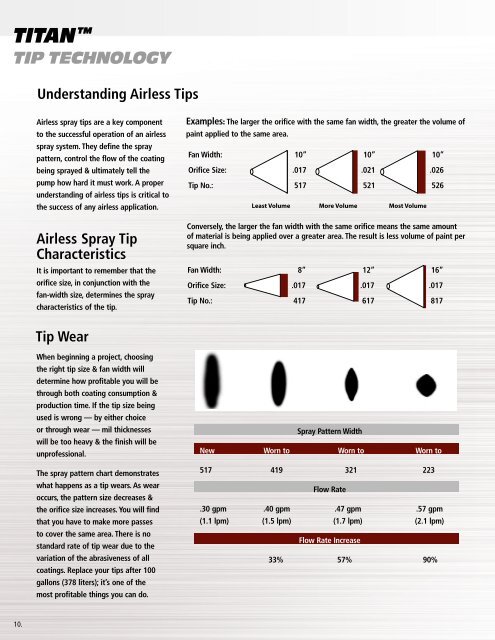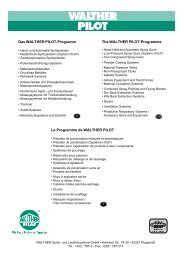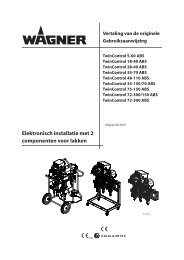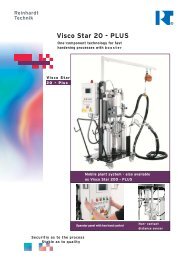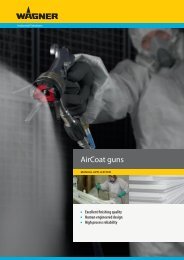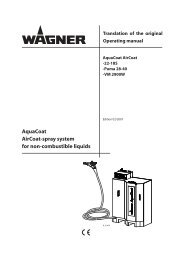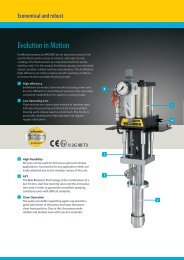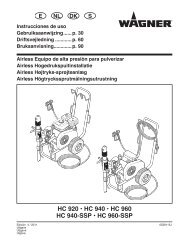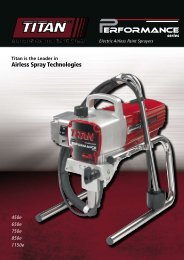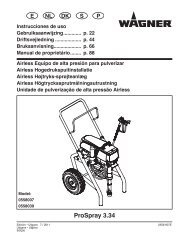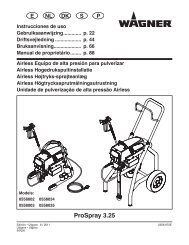Airless Accessories - Wagner
Airless Accessories - Wagner
Airless Accessories - Wagner
You also want an ePaper? Increase the reach of your titles
YUMPU automatically turns print PDFs into web optimized ePapers that Google loves.
TITAN<br />
TIP TECHNOLOGY<br />
Understanding <strong>Airless</strong> Tips<br />
<strong>Airless</strong> spray tips are a key component<br />
to the successful operation of an airless<br />
spray system. They define the spray<br />
pattern, control the flow of the coating<br />
being sprayed & ultimately tell the<br />
pump how hard it must work. A proper<br />
understanding of airless tips is critical to<br />
the success of any airless application.<br />
<strong>Airless</strong> Spray Tip<br />
Characteristics<br />
It is important to remember that the<br />
orifice size, in conjunction with the<br />
fan-width size, determines the spray<br />
characteristics of the tip.<br />
Examples: The larger the orifice with the same fan width, the greater the volume of<br />
paint applied to the same area.<br />
Fan Width: 10” 10” 10”<br />
Orifice Size: .017 .021 .026<br />
Tip No.: 517 521 526<br />
Least Volume More Volume Most Volume<br />
Conversely, the larger the fan width with the same orifice means the same amount<br />
of material is being applied over a greater area. The result is less volume of paint per<br />
square inch.<br />
Fan Width: 8” 12” 16”<br />
Orifice Size: .017 .017 .017<br />
Tip No.: 417 617 817<br />
Tip Wear<br />
When beginning a project, choosing<br />
the right tip size & fan width will<br />
determine how profitable you will be<br />
through both coating consumption &<br />
production time. If the tip size being<br />
used is wrong — by either choice<br />
or through wear — mil thicknesses<br />
will be too heavy & the finish will be<br />
unprofessional.<br />
The spray pattern chart demonstrates<br />
what happens as a tip wears. As wear<br />
occurs, the pattern size decreases &<br />
the orifice size increases. You will find<br />
that you have to make more passes<br />
to cover the same area. There is no<br />
standard rate of tip wear due to the<br />
variation of the abrasiveness of all<br />
coatings. Replace your tips after 100<br />
gallons (378 liters); it’s one of the<br />
most profitable things you can do.<br />
Spray Pattern Width<br />
New Worn to Worn to Worn to<br />
517 419 321 223<br />
Flow Rate<br />
.30 gpm .40 gpm .47 gpm .57 gpm<br />
(1.1 lpm) (1.5 lpm) (1.7 lpm) (2.1 lpm)<br />
Flow Rate Increase<br />
33% 57% 90%<br />
10.


